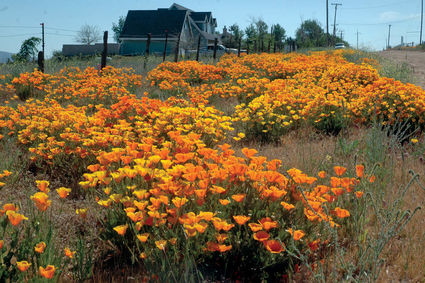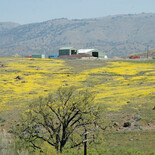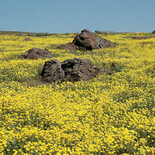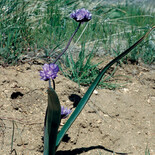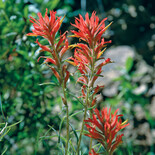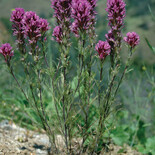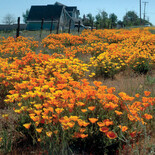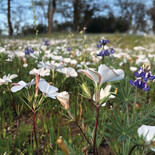The colors of Spring - Common wildflowers of the Tehachapi Mountains
Land of Four Seasons
April 27, 2019
Spring can be an amazingly beautiful time in the Tehachapi Mountains, especially after wet winters like we've had this year, when frequent storms are followed by a rainbow of colored wildflowers. It has been said that "The Earth laughs in flowers" and our mountains this year have been giving us wild blossoms in laughing abundance.
I've compiled a list of some favorite wildflowers that thrive in our area. Most of these ephemeral beauties are blooming right now.
All of our native plants face this daunting reality: most of our moisture comes in winter when cold temperatures limit growth, then in spring as the mercury rises and growing conditions improve, the storms abruptly stop.
These wildflowers have managed to adapt to that yearly cycle and we're the richer for their flowering success.
California Poppies
(Escholtzia californica)
It would be hard to make a general list of California wildflowers and leave off our state flower. These lovable plants flower throughout the Tehachapi area and while best known for a pumpkin-orange color, variant poppies may be found whose colors include pure white, pale yellow, pink or even reddish. Early Spanish explorers called them "Cupa de oro," or "Cups of gold," and a dense stand of California Poppies can make a hillside glow with the light of 10,000 little saffron-colored lanterns.
Baby Blue Eyes
(Nemophilia menziesii)
These sweet low-growing little annuals are unmistakable with their flowerheads of bright blue with white centers. Typically blooming at the height of wildflower season in March and April, Baby Blue Eyes raise their soft faces to the warming sun and like tiny reflecting pools, their blue-and-white color scheme mirrors the deep blue Tehachapi skies and cottony white cumulus clouds overhead.
Hilltop Daisies
(Monolopia lanceolata)
Totally gregarious, these two-toned yellow ray flowers are more commonly found growing in huge colonies rather than alone. The flowers are darker at the center and lighter toward the outside margins, growing even lighter as the blossoms fade. They often create a shifting lake of yellow flowers on the treeless foothills north of the town of Tehachapi above Highway 58 on Loop Ranch property
Cream Cups
Often found growing in the vicinity of Baby Blue Eyes, Cream Cups have flowers with spiky white centers and white petals that look like they'd been partially dipped in butter. The diminutive plants are covered with soft silky hairs, and until they open, the flowerheads look like miniature kiwifruit nodding at the end of slender stalks.
Owl's Clover (Castilleja exserta)
These attractive annuals prefer grassy fields and gentle foothill slopes, where its spiky flower clusters rise like little purple feather dusters. They derive their common name from features on the petals which look like tiny owls with white facial disks and colored eyes. Though they look purple from a distance, look closely at Owl's Clover and you'll see that most of the flower cluster is deep red with hot pink tips, and together these colors create a unique reddish lilac hue.
Indian Paintbrush
(Castilleja subinclusa)
There are several different Castilleja species commonly referred to as "Indian Paintbrush," and they are quite similar in appearance.
Although they appear to produce flowering stalks with many bright red flower petals, the red parts are actually bracts – specialized leaf structures – that occur around the flowers themselves, which are small yellow tubular flowers that protrude from the bracts themselves.
Lupines (Lupinus species)
The upright flowering stalks of lupine are a common sight in Kern County – there are 25 species and seven subspecies of Lupines growing here, making Lupinus the fifth-best represented genus in the county. Lupines growing locally include both annuals and perennials and range in height from tiny Pygmy-leaved Lupines that are only a few inches tall to Bush Lupines that may reach five feet. They come in an array of colors, including white, blue, lavender, purple, pink and bi-colored.
Popcorn Flower
(Plagiobothrys arizonicus)
These subtle plants produce tiny clusters of white blossoms on the top slender stalks. Popcorn Flowers frequently grow among other spring-blooming wildflowers and thus perform the same task as Baby's Breath in a flower arrangement – the delicate sprays of small white flowers providing an accent to Lupines, Owl's Clover, Filaree, California Poppies and more. They have a pleasant fragrance and Popcorn Flowers attract nectar-loving insects, especially small butterflies.
Evening Snow
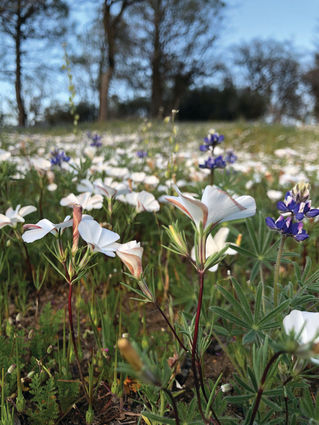
Jon Hammond
Evening Snow blooms in the hills above Tehachapi. They stay tightly curled up until about 4 or 5 p.m. then are open all night long. They close again when the morning sky lightens. They are white as snow, except for a curving reddish outside edge.
(Linathus dichotomus)
Evening Snow owes its common name to the fact that it blooms in late afternoon when the sun is setting, just as most other wildflowers are closing for the night.
As sunlight dims, these magical plants unfurl their funnel-shaped white flowers and transform slopes and ravines with their pearly white blossoms. They remain open for the duration of the night and then, like an actual spring snow, they "melt" away with the morning sun and virtually disappear as the flowers roll up like tiny closed umbrellas.
Wild Hyacinth
(Dichlostemma capitatum)
These perennials arise from bulb-like corms in the ground, delightful little purple surprises which then vanish again as the weather warms and the soil dries.
The corms were cooked and used as food by American Indian tribes, including the local Nuwä (Kawaiisu) Indian people.


